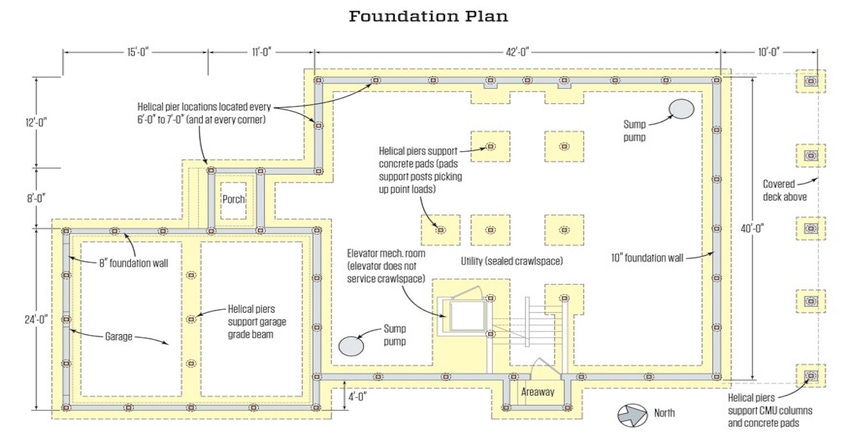Building a Concrete Foundation on a Wet Site
A grade beam footing supported by 59 helical piers allows this concrete foundation to "hover" above the water table.
August 22, 2023

Journal of Light Construction
Distinctive Contracting Services is building a house on the waterfront of the Magothy River, near Annapolis, Maryland, in an area where soil conditions are too inconsistent for a conventional foundation. The building site is about 60 feet from the water’s edge, with significant groundwater at 3 to 4 feet below grade. To avoid any possibility that the foundation would settle in those saturated soil conditions, plans called for the new home to be supported by a concrete grade beam and a series of concrete pads bearing on 59 helical piers, each penetrating 17 to 18 feet below ground level.
Distinctive Contracting Services, which has about 20 years of experience using helical piers (called piles in the area) in a variety of applications, did the layout and pier installation and worked directly with the subcontractors and tradespeople who excavated the site and formed and poured the grade beam and walls.
Helical Piers
On most of Distinctive Constracting's projects, the helical pier supplier—typically either Pier Tech or Ideal—does the general engineering for loads based on the plans that we provide, and a local engineer then checks the loads and certifies the plans. The most common helical pier we install measures 2 7/8 inches in diameter and, when installed to 1,000-foot-pounds of torque, will support 9x loads (i.e., 9,000 pounds of weight). On this project, the target was 1,670-foot-pounds of torque for 15,000 pounds of load per pier. The load bearing range for a helical pier is often referred to in terms of kips, or kilo-pounds. So, for example, 15,000 pounds of bearing equals 15 kips.
The contractor installed the piers using our 10,000-pound mini-excavator, which is equipped with a torque head that’s fitted with hydraulic pressure sensors coupled to a digital drive monitor. This allows the company to do a calculated readout of the torque achieved based on the difference between the input hydraulic pressure and the return pressure. With the firm's digital equipment, the contractor downloaded the data and provide it to an engineer as proof of successful installation, which often saves on witness testing or having to hire an engineer to perform on-site witness verification, which can be costly.
For the rest of the story, including diagrams, from JLC, click here.
You May Also Like


